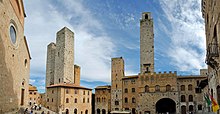Skyline: Difference between revisions
No edit summary Tag: Reverted |
|||
| Line 3: | Line 3: | ||
{{unfocused|date=May 2018}} |
{{unfocused|date=May 2018}} |
||
{{short description|Outline or shape viewed near the horizon}} |
{{short description|Outline or shape viewed near the horizon}} |
||
[[File: |
[[File:SingaporeCBD2.jpg|thumb|upright=1.3|Skyline of [[Singapore]]]] |
||
A '''skyline''' is the [[wikt:outline|outline]] or [[shape]] of terrestrial objects viewed near the [[horizon]]. It can be created by a [[cityscape]] or [[landscape]], by human intervention in a rural setting, or in nature where the sky meets buildings or [[landform]]s. Skylines serve as a visual "[[fingerprint]]" for a city, as each city is unique. Hence, television programs and films often display the skyline of a city to indicate a location or to [[establishing shot|establish]] the [[setting (narrative)|setting]]. |
A '''skyline''' is the [[wikt:outline|outline]] or [[shape]] of terrestrial objects viewed near the [[horizon]]. It can be created by a [[cityscape]] or [[landscape]], by human intervention in a rural setting, or in nature where the sky meets buildings or [[landform]]s. Skylines serve as a visual "[[fingerprint]]" for a city, as each city is unique. Hence, television programs and films often display the skyline of a city to indicate a location or to [[establishing shot|establish]] the [[setting (narrative)|setting]]. |
||
Revision as of 02:34, 15 December 2021
This article may lack focus or may be about more than one topic. (May 2018) |

A skyline is the outline or shape of terrestrial objects viewed near the horizon. It can be created by a cityscape or landscape, by human intervention in a rural setting, or in nature where the sky meets buildings or landforms. Skylines serve as a visual "fingerprint" for a city, as each city is unique. Hence, television programs and films often display the skyline of a city to indicate a location or to establish the setting.
The term The Sky Line of New York City was first introduced in 1896, when it was the title of a color lithograph by Charles Graham for the color supplement of the New York Journal.[1] Paul D. Spreiregen, FAIA, has called a [city] skyline "a physical representation [of a city's] facts of life ... a potential work of art ... its collective vista."[2]
Features
High-rise buildings

High-rise buildings, including skyscrapers, are the fundamental feature of urban skylines.[3][4] Both contours and cladding (brick or glass) make an impact on the overall appearance of a skyline.
Towers

Towers from different eras make for contrasting skylines.
San Gimignano, in Tuscany, Italy, has been described as having an "unforgettable skyline" with its competitively built towers.[5]
Remote locations

Some remote locations have striking skylines, created either by nature or by sparse human settlement in an environment not conducive to housing significant populations.
Architectural design
Norman Foster served as architect for the Gherkin in London and the Hearst Tower in Midtown Manhattan, and these buildings have to added to their cities' skylines.
Albert Speer made a notable night time skyline with searchlights at Nuremberg.
Use in media
Skylines are often used as backgrounds and establishing shots in film, television programs, news websites, and in other forms of media.
Subjective ranking
Several services rank skylines based on their own subjective criteria. Emporis is one such service, which uses height and other data to give point values to buildings and add them together for skylines. The three cities it ranks highest are Hong Kong, Seoul and Shenzhen.[6]
See also
References
- ^ "Moving Uptown". New York Public Library. Archived from the original on 2014-12-29.
When Charles Graham's view of New York was published, the new term used in the title, "sky line," caught on immediately.
- ^ Paul D. Spreiregen (1965). Urban Design: The Architecture of Towns and Cities. McGraw-Hill.
- ^ Heath, Tom; Smith, Sandy G.; Lim, Bill (July 2000). "Tall Buildings and the Urban Skyline: The Effect of Visual Complexity on Preferences". Environment and Behavior. 32 (4): 541–556. doi:10.1177/00139160021972658. ISSN 0013-9165. S2CID 5199331.
- ^ McNeill, Donald (February 2005). "Skyscraper geography". Progress in Human Geography. 29 (1): 41–55. doi:10.1191/0309132505ph527oa. S2CID 220928675.
geographers have tended to neglect the substantial impact of skyscrapers on urban life.
- ^ Centre, UNESCO World Heritage. "Historic Centre of San Gimignano". whc.unesco.org. Archived from the original on 2016-08-04.
- ^ "Skyline Ranking". Emporis. Retrieved 29 April 2021.
Further reading
- Emporis ranking of cities by the visual impact of their skylines
- Attoe, Wayne (1981). Skylines: understanding and molding urban silhouettes. Wiley. ISBN 9780471279402.
- Bacon, Edmund (1967). Design of Cities. Thames & Hudson. ISBN 978-0-14-004236-8.
- Lim, Bill; Heath, Tom (1993). Hayman H. (ed.). "What is skyline: a quantitative approach". Architectural Science: Past, Present and Future, Proceedings of the Conference of the Australian and New Zealand Architectural Science Association: 23–32.
- Ford, Larry R. (1976). "The urban skyline as a city classification system". Journal of Geography. 75 (3): 154–164. doi:10.1080/00221347608980594.
